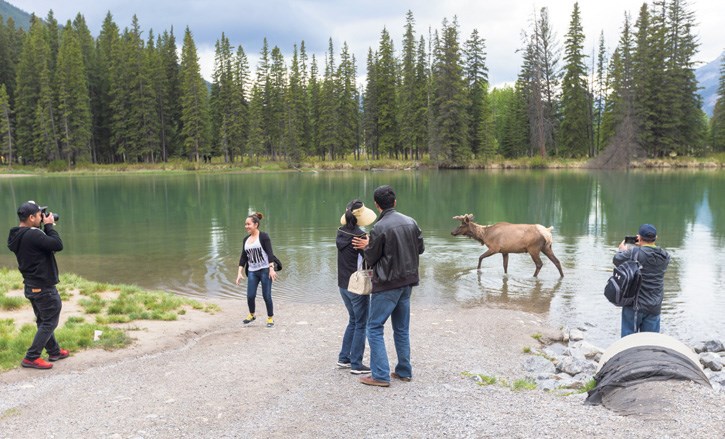BANFF – The Town of Banff is looking to hire a consultant to assess the effects residents and tourists have on critical wildlife corridors near the national park townsite.
Council has tentatively set aside $30,000 in the operating budget to bring in an independent biologist, but it’s not a done deal until the operating budget is debated and finalized.
Town of Banff officials say the contractor would analyze years of wildlife monitoring data, and then provide advice to the municipality on the community’s impacts on the Fenlands-Indian Grounds, Sulphur and golf course corridors.
Chad Townsend, the Town’s environmental services manager, said wildlife in the valley need to be able to effectively use their natural habitat with minimal human disturbance, while avoiding towns and campgrounds.
“Wildlife corridors have been a topic we hear most about from Canmore, but we have movement corridors that have been identified over the years where we have land uses at the very least adjacent, if not within the corridors,” he said.
“We are seeking to better understand what we could do differently with how we manage humans and our future planning to maximize benefits of these corridors, allowing wildlife to move around the town, but hopefully not travelling within.”
The Bow Valley includes prime, valley bottom montane lands that are extremely rare and highly desirable for wildlife, and provide critical corridors for wildlife movement.
However, much of the valley bottom is taken up with residential and commercial development, with the Trans-Canada Highway and Canadian Pacific Railway running through the middle.
For land managers, maintaining and restoring wildlife corridor effectiveness has been an ongoing challenge, especially in the face of increasing human use and expanding development.
The Bow Valley human-wildlife coexistence taskforce came up with 28 recommendations focusing on reducing the probability and severity of wildlife encounters, including a recommendation to reduce human footprint in corridors.
Ongoing research shows wildlife such as bears require secure habitat with low levels of human disturbance to feed, rest and reproduce, as well as secure movement corridors so they can move around, rather than through urban areas.
“Failure to maintain effective wildlife corridors results in long-term ecological impacts, by preventing wildlife from moving between habitats,” concluded the taskforce in its report released earlier this year. “It can also increase the likelihood of wildlife incursions into the communities as they attempt to move within the valley.”
Banff Mayor Karen Sorensen, who was co-chair of the human-wildlife coexistence roundtable, voiced support for moving forward with a $30,000 wildlife corridor effectiveness study.
“When a report comes out with all this time and effort, it’s just so important to move forward with the recommendations and not let it just sit on a shelf,” she said.
“Even in our own very environmentally conscious community that we live in, there is always room for improvement.”
The Bow Valley human-wildlife coexistence round table was created in late 2017 in response to concerns about the number of encounters between humans and wildlife, and how those encounters were being managed by local, regional and national agencies.
It was the management of a particular female grizzly bear known as No. 148 and her movements over that summer that highlighted the challenges wildlife face in a populated valley managed by different federal and provincial agencies.
After several encounters, grizzly 148 was shipped out of Canmore to unfamiliar territory in Kakwa Wildland Provincial Park north of Jasper at the end of July. Within two months, she was shot dead by a hunter in the then-legal hunt in B.C.
In neighbouring Canmore, a human-use study by the Town of Canmore and Alberta Environment and Parks showed extensive human-use in corridors and habitat patches are negatively affecting the ability of wildlife to use those areas.




